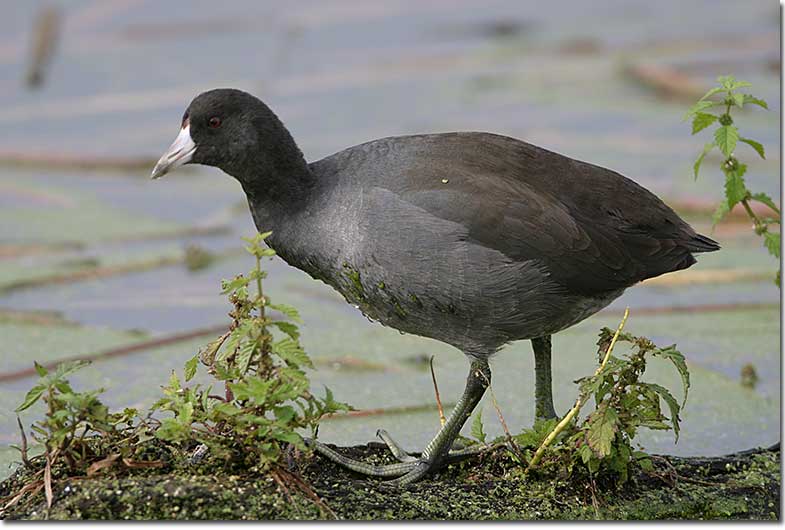The American Coot is an odd, dark, duck-like bird that breeds in lakes, ponds, freshwater marshes, and other wetlands from the Great Lakes region to central and western Canada, much of the central and western USA, Mexico, and on several Caribbean islands.
This distinctive member of the rail family is the only bird in its range with a blackish body and a stubby, chalky white bill.
It dabbles on the surface of the water and walks in grassy areas next to wetlands to eat bugs, small aquatic creatures, and bits of grain and vegetation, and makes odd honking and grunting sounds.
On this page
Identification
The American Coot is an aquatic member of the rail family about the same size as a chicken or small duck. This plump bird has blackish plumage that is more velvet black on the thick neck and head, and with dark gray highlights on the body.
The rounded head is decorated with its most distinctive field mark; a rather stubby, white bill with a white “shield” on the front of the head. There is also a bit of reddish-brown near the tip of the bill and reddish-brown at the top of the white frontal shield.
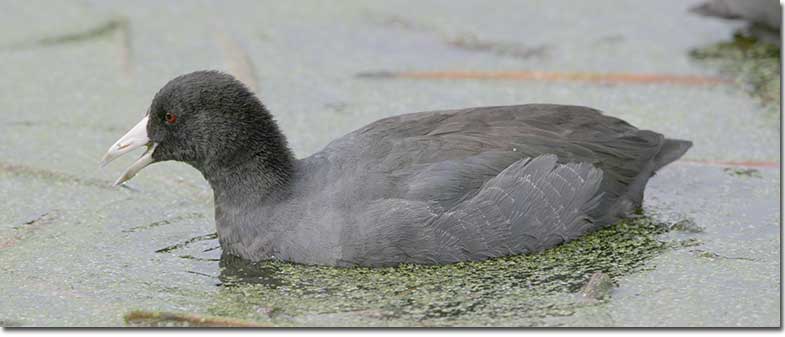
American Coot
The reddish eyes of the American Coot stand out on its velvety black head.
Females and males of the American Coot look the same, but males tend to be slightly bigger. The female also has different vocalizations but, without a lot of practice, these are complex and can be tough to discern. In general, the grunting and squawking notes of the female are more nasal.
Both sexes also have rounded wings that show a narrow white line on part of the trailing edge of the wing when the bird takes flight.
American Coots don’t fly that often, but when they do, they run on the water while quickly flapping their wings to become airborne.
During flight and while foraging on the ground, the legs and oddly webbed feet are also visible. These can be greenish-yellow or yellowish with orange highlights.
Juvenile American Coots have hair-like feathers and are black with orange on the neck and pinkish-red on the bill and head. In late summer and fall, juvenile coots are as big as adults and look similar but have paler gray plumage and a grayish bill.
Food
The American Coot feeds on a wide variety of small aquatic insects, beetles, and other small creatures such as crustaceans, small fish, and tadpoles, but vegetation makes up the largest part of its diet.
It eats algae and other aquatic vegetation, grasses, and some grains including various types of pond weeds, wild rice, oats, and some seeds and tubers.
As they float on the water, this coot species forages for both vegetation and small aquatic creatures by using its bill to pick food items from the surface.
American Coots dip their heads below the water to pick leaves and other food from underwater vegetation and the bottom of the marsh or pond. If the water is deep enough, they won’t hesitate to dive below the surface to forage.
Although coots are highly aquatic, they can also forage on land. When looking for food on land, they stand around and clumsily walk to pick up bits of vegetation, grasses, grains, and, when the opportunity presents itself, insects.
American Coots are also quite opportunistic and have been seen eating carrion, even picking bits of feathers and flesh from dead ducks and other birds. On occasion, they also steal food from ducks.
Nesting and Eggs
The female American Coot carries out the majority of nest construction but, in some places, males have also been seen bringing nesting material to the female, and they also help maintain and fix the nest structure.
Before nesting, several potential nest platforms are built with bits of dead vegetation and one is eventually chosen by the female.
The nest is a floating platform anchored and attached to emergent marsh vegetation and has to be maintained on a daily basis to keep the vegetation at the bottom of the nest from rotting away and the nest platform then falling apart.
Inside, it is more or less shaped like a basket, has softer vegetation where the eggs are laid, and is a foot in diameter.
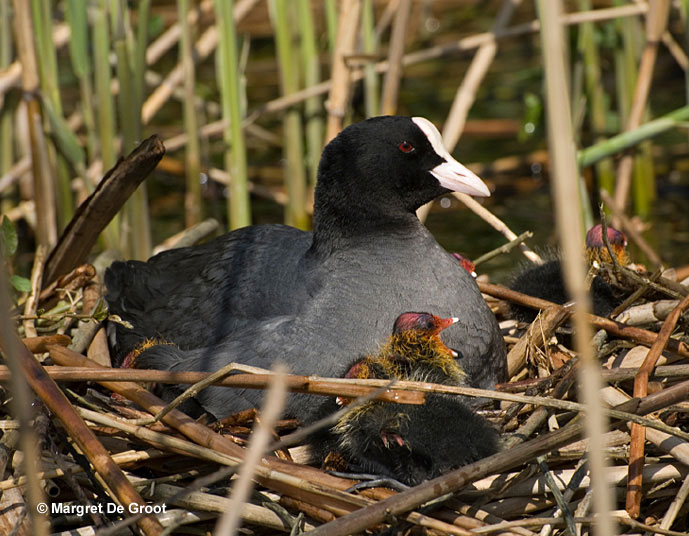
The nest is built and usually hidden in dense areas of emergent freshwater vegetation such as cattails, bulrushes, and sedges.
Eight to twelve buff-colored eggs weighing 29 grams and with reddish-brown speckles are incubated for 23 to 25 days by both sexes, males usually incubating at night.
After hatching, baby American Coots fluff and dry their feathers for at least six hours and then leave the nest to swim in the water near their parents.
Some can stay in the nest with their parents for up to two days and young birds start pecking at food items as soon as they leave the nest. They are also fed by parent birds and stay close to them for at least 30 days. After that time, they become much more independent.
Current Situation
American Coots breed in shallow marshes and other wetlands with lots of emergent vegetation from the Great Lakes region west to central and western Canada, much of the central and western USA, plateaus and mountainous areas in Mexico, and on islands in the Caribbean Sea.
During migration and winter, flocks of American Coots also frequent water treatment plants, coastal marshes, lakes, and other wetland habitats in parts of their breeding range as well as much of the southern United States to Central America.
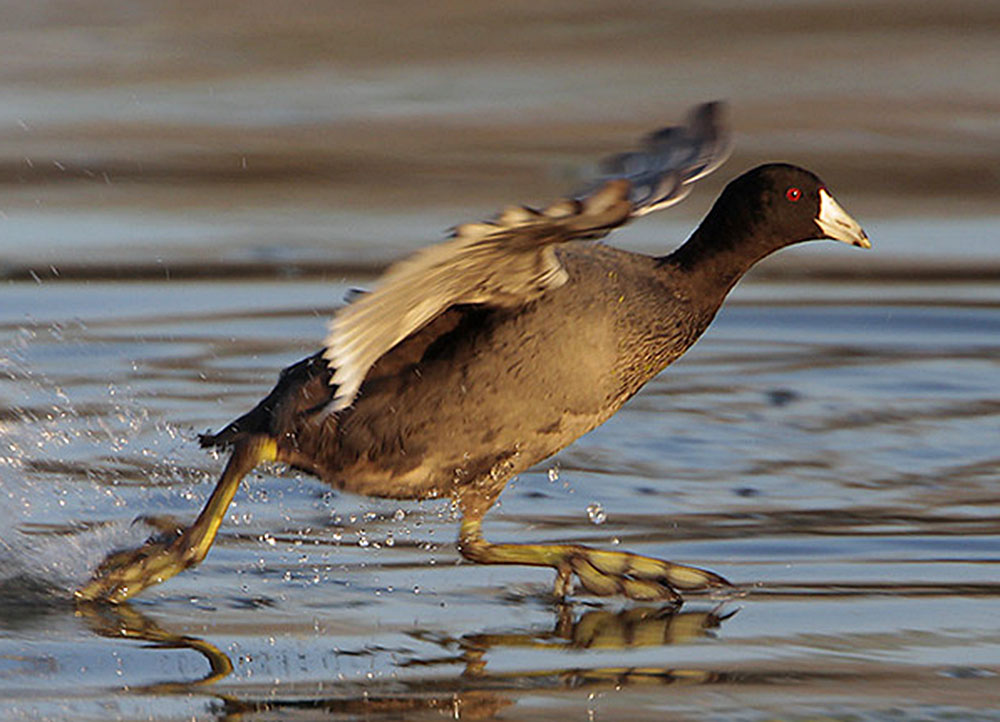
This bird species is considered common and is not endangered. Although the population is currently stable and estimated at 3 million in Canada and the USA, before the late 1800s, the population was much larger.
The American Coot declined at this time and into the early twentieth century as a consequence of over hunting, and drainage of large areas of wetland habitat. This species may be affected by pollution in some places, but the overall population appears to be stable.
Facts
- Instead of having webbed feet like a duck, the feet of the American Coot have “lobed” skin between their toes. This adaptation helps coots swim better and walk on land.
- Although coots look sort of like ducks, they are more closely related to the majestic cranes and reclusive rails.
- In winter, American Coots can form flocks of thousands of birds. They usually do this in lakes and other places with extensive open water.
- This species plays an important role for marsh habitats by eating large amounts of excess vegetation.
Similar Species
With its stubby white bill and duck-like appearance, few other birds resemble the American Coot, at least within its range. However, there are a few other species that could be potentially confused with the American Coot.
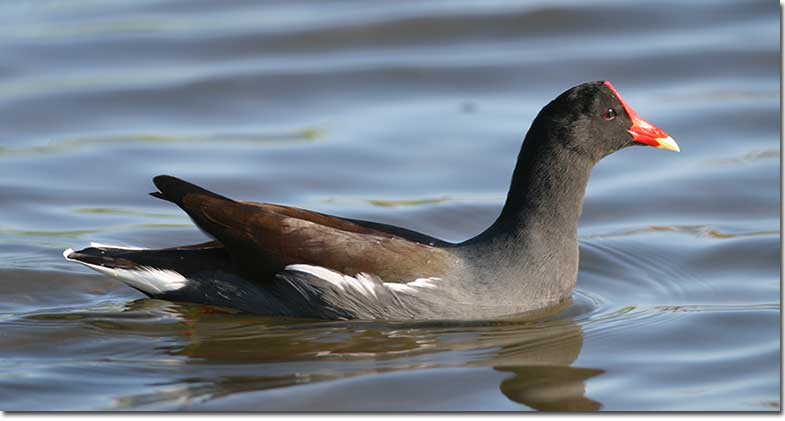
Common Gallinule
The Common Gallinule has a similar shape, also has blackish plumage, and lives in the same marsh habitats as the American Coot. Common Gallinules have some yellow or bright red on their bill, a white line on the flank, and more white near the tail.
They also swim less than American Coots.
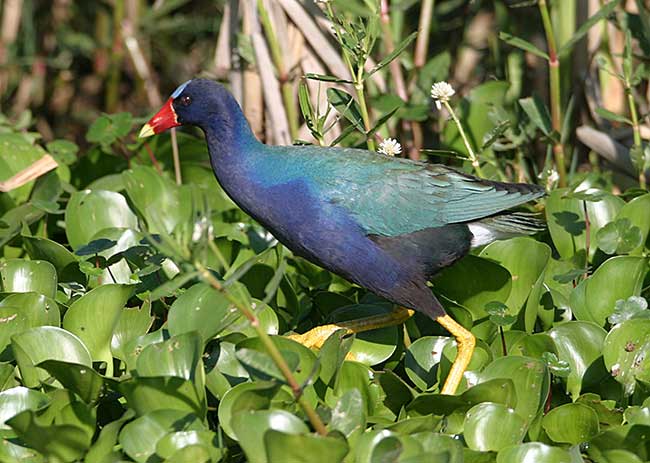
Adult. © Sam Crowe
The Purple Gallinule is also shaped like a coot but doesn’t swim as much.
Contrary to American Coots, Purple Gallinules have beautiful purple-blue plumage and some green.
Young birds are browner than American Coots and have a yellowish bill.
Frequently Asked Questions
What is the difference between American and Eurasian Coot?
The main difference between the American Coot and the Eurasian Coot is the Eurasian Coot’s all white bill and larger white frontal shield, and their range. The American Coot lives in North America while the Eurasian Coot lives in Europe, Africa, Asia, and Australia.
Where does the American Coot live?
The American Coot lives in freshwater marshes and other wetlands from the Great Lakes area west to central and western Canada, in much of the central and western USA, in Mexico, and on most Caribbean islands.
Are American Coots rare?
No. American Coots are common birds easy to see in most of their range.
Are American Coots endangered?
No. American Coots are not endangered and have a stable estimated North American population of 3 million birds.

